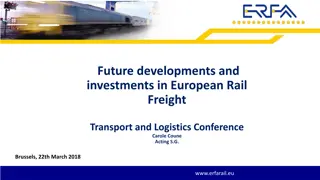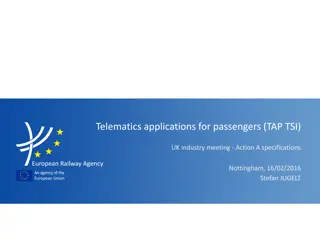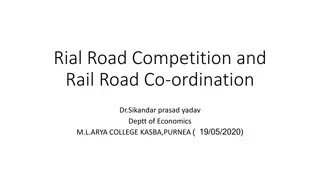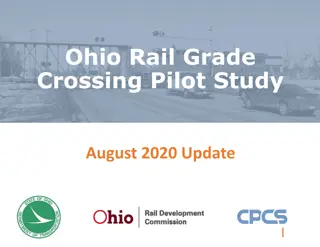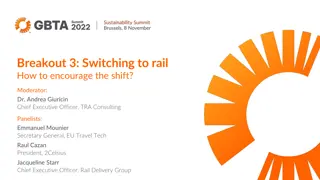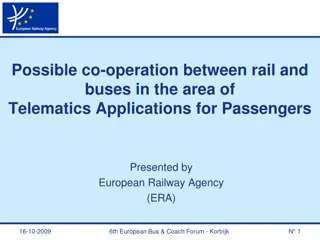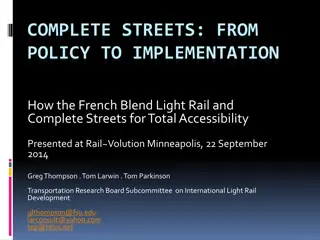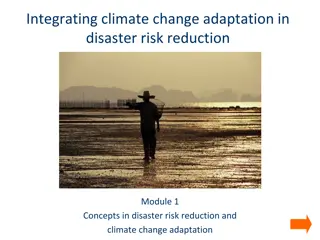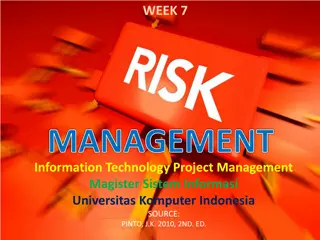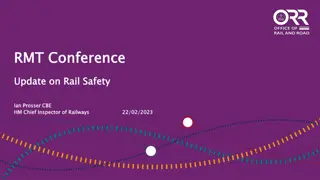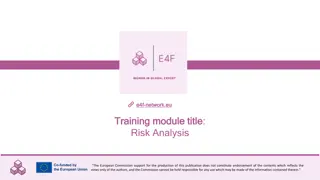Management of Runaway Risk in Rail Environments - Technical Brief Module 05
This technical briefing by Network Rail addresses the risk of runaway plant in rail environments following a significant accident and regulatory requirements. Module 05 outlines controls, responsibilities, and measures to prevent or reduce the risk of runaways involving rail-mounted plant. Specific definitions, including those of runaway and rail-mounted plant, are provided along with criteria for identifying locations at risk from runaways.
Download Presentation

Please find below an Image/Link to download the presentation.
The content on the website is provided AS IS for your information and personal use only. It may not be sold, licensed, or shared on other websites without obtaining consent from the author. Download presentation by click this link. If you encounter any issues during the download, it is possible that the publisher has removed the file from their server.
E N D
Presentation Transcript
Management of Runaway Risk NR/L2/OHS/019 Module 05 Technical Brief 2021 Compliance date: 6th March 2021
This is a technical briefing issued by Network Rail regarding the risk of runaway plant. This briefing MUST be provided to all Sentinel Card holders on or before 1st March 2021 Ensure all Sentinel Cardholders sign the briefing record once they have received this briefing
Management Of Runaway Risk Following the Tebay accident on 15 February 2004, and the subsequent ORR requirements for Network Rail to improve the arrangements for dealing with runaway risk, Network Rail and the Trade Unions agreed to work together on a workstream focussed on the potential risk of runaways by Rail Mounted Plant. Network Rail and the Trade Unions discussed and agreed a formal hierarchy of controls that would eliminate or reduce the risks associated with runaways in possessions. The arrangements are now to be included as a supporting module 05 to the NR/L2/OHS/019 standard Version: 2.0 January 2021
Management Of Runaway Risk Module 05 aligns with section 9.2 of the current NR/L2/OHS/019 standard, and includes: Additional definitions relating to runaway risk Responsibilities and actions of those that create the risk Responsibilities and actions of those that are exposed to the risk Hierarchy of control measures to remove or reduce the risk, included in a flowchart format Appointed Watchman and the limitations placed upon the deployment of a watchman. Version: 2.0 January 2021
Management Of Runaway Risk See the definitions in NR/L2/OHS/019. The following definitions apply to module 05 only: The unauthorised and uncontrolled movement of Rail Mounted Plant. Runaway Any plant that has rail wheels or runners that can run on the track either self-propelled or manually propelled. This includes on track machines, on track plant, trolleys, skates, scooters, etc. (as per NR/L2/RMVP/0200) Rail mounted plant Watchman Person appointed to warn of an approaching runaway Version: 2.0 January 2021
Management Of Runaway Risk Locations with specific runaway risks A site of work is deemed at risk from runaways where rail mounted plant is to be used and the following conditions apply: the site of work is on a gradient steeper than 1 in 100 or has a gradient steeper than 1 in 100 within 5 miles of the site of work; the site of work is in a possession; and work is taking place on or near the line. Note: The requirement for the site of work to be static has been removed as both static and moving sites are equally at risk from potential runaways Version: 2.0 January 2021
Management Of Runaway Risk 1. Eliminate the risk by re planning the work to be carried out at another opportunity where the risk to others no longer exists. Isolate the risk by creating a barrier that prevents the runaway from leaving the site of work e.g. a rail removed as part of the work activity. 2. Set points to isolate the pathway of the equipment causing the risk and restrict its ability to enter another site uncontrolled. 3. When using this as a control, confirm it does not introduce risk to other work groups. Manage the risk by compliance to GE/RT 8000 Handbook 10 Duties of the COSS or SWL and person in charge when using a hand trolley, and NR/L2/RMVP/0200 Infrastructure Plant Manual. 4. If assistance is required to determine compliance requirements, seek advice from the On-Track Plant Specialist or organisational equivalent. Version: 2.0 January 221
Management Of Runaway Risk Eliminate the risk by re planning the work to be carried out at another opportunity where the risk to others no longer exists. Identify if the work activity has created a barrier that prevents the runaway from entering the site of work (e.g. where a rail has been removed as part of the work activity). 1. 2. Set points to isolate the pathway of the equipment causing the risk and restrict its ability to enter the site of work uncontrolled. 3. When using this as a control, confirm it does not introduce risk to other work groups e.g. where the point setting cannot be maintained. Implement a Secondary warning system by use of an approved system at the site of work of the potential at risk work groups. 4. Where there is more than one potential at risk work group, arrangements can be agreed between responsible managers, planners and persons in charge for one secondary warning system to be deployed at the initial at-risk site, and supplementary warning systems between workgroups can be agreed. 5. Use of an appointed watchman who cannot be involved in the work activity. Version: 2.0 January 21
Management Of Runaway Risk Appointed watchman The watchman role is a capability not a competence. When deploying a watchman the following shall be applied: the watchman shall be identified as a method of warning during the planning stage and the details shall be added to the SSOWPS controls measures box; the watchman shall be appointed by the PIC or COSS (if delegated COSS duties); the watchman shall be placed and remain in a position of safety; the watchman shall have Lookout competence; the watchman shall not be deployed during darkness, poor visibility or in a tunnel; the watchman shall have a sighting distance of 500yds/460m minimum; the watchman shall not be involved in the work; the watchman shall be close enough to the group to confirm all staff receive warnings; the watchman shall have sight of all staff to be warned at all times; where noise is involved the COSS or PIC shall use the touch warning method; the watchman shall have a whistle or horn (Ideally they should carry both) if the watchman cannot maintain the agreed sighting distance/visibility, or needs to stand down, they shall inform the PIC/COSS and warn personnel to move to a position of safety; watchmen shall be rotated from duty every two hours with a 20-minute break before reassuming duty. Version: 2.0 January 21
Management Of Runaway Risk If you have questions or queries regarding the information contained with this briefing please contact us on: 01323 887186, or email info@prb-consulting.co.uk Version: 2.0 January 221
Briefing Record NAME DATE SENTINEL NUMBER SIGNATURE Management Of Runaway Risk



